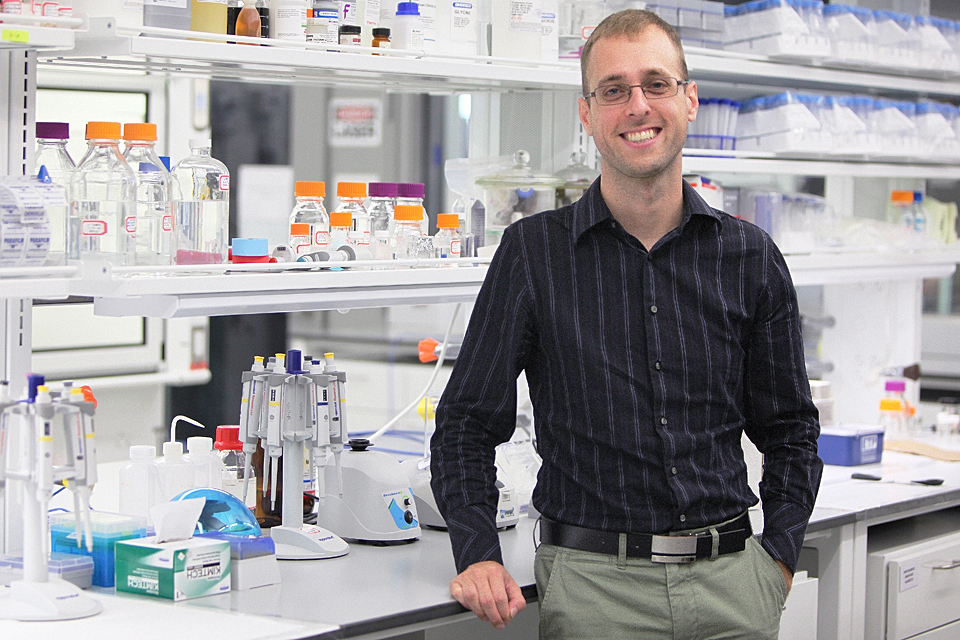The Arnold and Mabel Beckman Foundation has named Peter Nemes, an assistant professor of chemistry at the George Washington University, a 2015 Beckman Young Investigator.
Dr. Nemes will receive $750,000 over the next four years to develop a new technology that can identify and quantify proteins expressed by a single neuron in the mammalian brain. The novel method could allow researchers to better understand the intricate molecular processes that underlie neurodevelopmental disorders like schizophrenia, Alzheimer’s disease and autism.
The Beckman Young Investigator program provides research support to “the most promising young faculty members” in the chemical and life sciences fields. Dr. Nemes is one of only eight scientists to receive the distinction this year.
“It is a great honor for me personally and for GW,” Dr. Nemes said. “It shows that the direction I’m taking to combine technology development and biology raises new potentials to advance human health.”
Dr. Nemes joined the laboratory of GW Chemistry Professor Akos Vertes as a Ph.D. student in 2005. As a member of the Vertes Research Group, he helped to develop the Laser Ablation Electrospray Ionization (LAESI) system, a now-commercialized product that enables researchers to more quickly and effectively learn the chemical composition of a biological sample.
After two years as a laboratory leader at the U.S. Food and Drug Administration, Dr. Nemes became an assistant professor in the Columbian College of Arts and Sciences in 2013. His research at GW has focused on advancing analytical tools to study the molecular underpinnings of basic biological processes in order to more meticulously investigate human disease.
The Beckman Foundation award will support Dr. Nemes’ goal to create a system that could transform modern neuroscience.
Understanding Proteins
Proteins are complex molecules that operate as the workhorse machinery in a cell and determine its health and function. Therefore, understanding how specific proteins are subtly implicated during neuron development is essential for examining and treating neurological disorders.
But technology available to detect, quantify and analyze the activity of individual proteins is limited. Recent advancements in genomics have enabled neuroscientists to determine how gene expression shapes brain development by studying the transcriptome—the set of all RNA molecules in a population of cells. However, without tools capable of analyzing single cells, scientists do not know how these expression patterns translate into the presence and activity of proteins.
Current mass spectrometry—an analytical measurement technique that converts chemicals into ions—can only analyze millions of cells in order to detect proteins, rather than investigate the components of a single cell.
“If you average out thousands or millions of neurons, you cannot tell if a cell specific in that population is performing some unique function or giving rise to disease,” Dr. Nemes said. “Ultimately, we need a new instrument that can downscale chemical analysis to the level of a single cell.”
With funding from the Beckman Foundation, Dr. Nemes plans to improve upon current mass spectrometry techniques and create a technology capable of analyzing the chemical composition of single neurons in the mammalian brain.
The technology builds upon a recent collaboration between Dr. Nemes and Sally A. Moody—a professor of anatomy and regenerative biology in the School of Medicine and Health Sciences (SMHS)—in which the researchers developed a prototype instrument that enabled the measurement of hundreds of metabolites and thousands of proteins in single embryonic cells isolated from frogs. The research was recently published in the Proceedings of the National Academy of Sciences.
In the next four years, Dr. Nemes plans to extract neurons from transgenic mice and then develop a new-generation tool to obtain detailed information about the types and abundance of the proteins present in single cells.
“We can then look at the differences between a healthy brain and a diseased brain so we can pinpoint which neural circuits might be impacted during the onset and development of neurodevelopmental diseases,” Dr. Nemes said.
The breakthrough would be a critical improvement for neuroscientists like Anthony LaMantia, the director of GW’s Institute for Neuroscience.
“At this point there is no good pathological signature for something like autism or schizophrenia,” Dr. LaMantia said. “And it’s clear that from just genetics alone, you can’t answer what’s wrong…. So, I think that a lot of answers are likely to come from these sorts of approaches—where you get down to populations of cells, that are uniform in one way, but when you begin to look quantitatively at their signature of proteins, you find that there are these differences.”
Dr. LaMantia and Chiara Manzini—an assistant professor of pharmacology and physiology—will collaborate with Dr. Nemes over the next four years. They will provide neurons harvested from transgenic mice and advise on applications for the research. Dr. Nemes and Dr. Manzini recently received the Dean’s Interdisciplinary Collaboration Excellence Award from the Columbian College of Arts and Sciences to utilize new analytical technology for developmental disease research, paving the way for translational research using the new instrument.
“This technology really promises fundamental insight,” Dr. LaMantia said, “into key issues that up to this point, we have not been able to address.”


